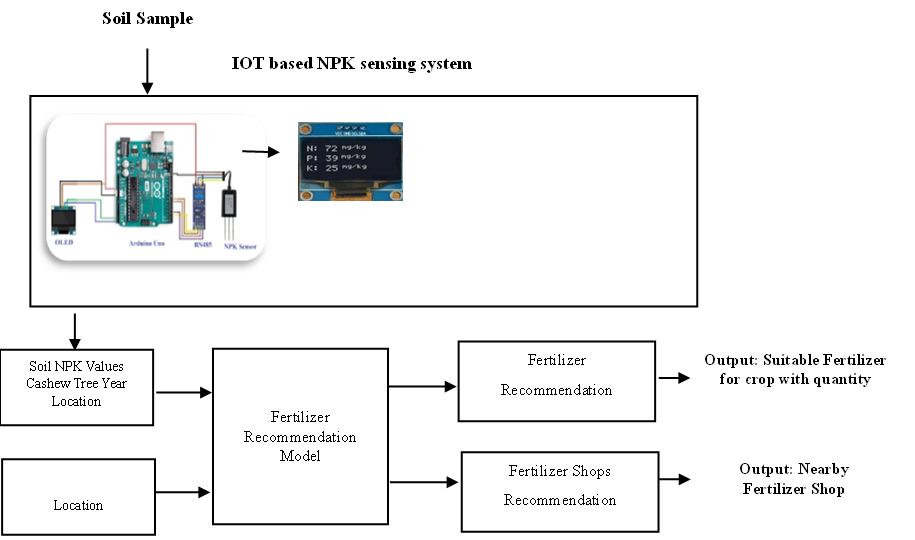An IoT based Tree Specific Soil Nutrient Management System Using Neural Network for Cashew Cultivation
Main Article Content
Abstract
Anacardium occidentale commonly known as Cashew was introduced into India by Portuguese in 16th century. Farmers of Cuddalore District, Tamil Nadu in India, are interested in Cashew Cultivation due to its export market values. To achieve better yield from cashew cultivation, farmers need to supply balanced nutrition to the soil and by following intercropping method. In literature, Recent Technologies like Artificial Intelligence and IOT are widely used to predict dosage of the fertilizer to be applied. By examining the numerous connected ascribe success locations of Cashew orchards, it was possible to determine how much macronutrients like Nitrogen (N), Phosphorus (P), and Potassium (K) were present in the soil and it will be helpful for the understanding of soil fertility level of the area. In our work, using IOT set up which includes Arduino UNO, NPK sensor and OLED display, we identified NPK values of soil for various cashew trees in a particular area. Along with NPK values of soil, inputs include the local soil type, PH and Tree age. Based on the input factors, DL trained model will provide suggestions of fertilizer dose to be applied for a specific tree for the Cashew cultivating farmers for better yield. In our proposed work, LSTM based Recurrent Neural Network (RNN) Algorithm is used to provide a better prediction of fertilizer. With the help of this research, we can be provided with what intercrop to plant and how much fertilizer to use, in what ratio to supply and fertilizer shop suggestion to enhance agricultural knowledge across the globe using the Internet of Things (IoT) and Artificial Intelligence. The result of RNN model was compared with Random Forest, Linear Regression, Linear Random Classifier, Decision Tree Classifier with proving accuracy of 98.7 %. Together with a decrease in the farmers' input efforts, these strategies will increase the productivity of the fields.
Article Details
References
Babu, V., Reddy, M.N.N., Rajanna, K.M. and Vidya, M. (2015). PERFORMANCE OF CASHEW TO NPK FERTILIZERS, Acta Hortic. 1080, 291-294 DOI: 10.17660/ActaHortic.2015.1080.37
S. Mangalassery, M. G. Nayak, P. Prabha Susan, T. R. Rupa, S. K.Behera & V. Srinivasan (2021): Delineating the nutrient constraints and developing nutrient norms for cashew (Anacardiumoccidentale L.) in coastal India, Journal of Plant Nutrition, DOI: 10.1080/01904167.2021.1921198.
T. Chitdeshwari, Santhi, R, K. Radhika, S.Sivagnanam, S. Hemalatha, Pradip Dey, A. Subba Rao, “GPS and GIS BASED Soil Fertility Mapping for Cuddalore District of Tamil Nadu”, Madras Agric. J., 2017, 104 (7-9): 251-257; doi: 10.29321/MAJ.2017.000054.
Sanjay Mate, “INTERNET OF THINGS (IoT) BASED IRRIGATION AND SOIL NUTRIENT MANAGEMENT SYSTEM”, i-manager’s Journal on Embedded Systems, Vol. 9 l No. 2 l January - June 2021.
Sudha C, K Jagan Mohan, “ Fast and Accurate Cashew Fruit Recognition using Deep Learning algorithm in Complex Orchards “, Gongcheng Kexue Yu Jishu/Advanced Engineering Science ISSN: 2096-3246 Volume 54, Issue 10, December, 2022, pp 3105-3116.
https://cashew.icar.gov.in/soil/
O.O. Olubode, T.T. Joseph-Adekunle, L.A. Hammed and A.O. Olaiya, “Evaluation of production practices and yield enhancing techniques on productivity of cashew”, Fruits 73(2), 75–100 | ISSN 0248-1294 print, 1625-967X online | https://doi.org/10.17660/th2018/73.2.1.
Sunanda Gavit, SB Dodak and NH Khobragade “Application of different levels of NPK along with soil and foliar application of zinc and boron in cashew for increasing production with sustainability”, International Journal of Chemical Studies 2020; 8(1): 3091-3094.
Olufemi Aremu-Dele, Kehinde Ademola Adesanya, Bunmi Olaoluwa Olorundare, Oluwadamilola Ifedolapo Asunbo and Elizabeth Feyisayo Odeyemi, “Intercrop practices in cashew production”, World Journal of Advanced Research and Reviews, 2021, 10(03), 281–288
Sivasankaran S, Dr. K. Jagan Mohan, Dr. G. Mohammed Nazer, “Prediction and Optimal Fertilizer Recommendation for Sustainable Cultivation of Groundnut Crop using Enhanced-1DCNN DLM”, International Journal of Advanced Computer Science and Applications, Vol. 13, No. 4, 2022.
https://agritech.tnau.ac.in/horticulture/horti_plantation%20crops_cashewnut.html
Revati P. Potdar, Mandar M. Shirolkar, Alok J. Verma, Pravin S. More & Atul Kulkarni (2021): Determination of soil nutrients (NPK) using optical methods: a mini review, Journal of Plant Nutrition, DOI: 10.1080/01904167.2021.1884702
M.S. Suchithra, Maya L. Pai, “Improving the prediction accuracy of soil nutrient classification by optimizing extreme learning machine parameters”, Information Processing in Agriculture, Volume 7, Issue 1, 2020, Pages 72-82.
T.O.Adejumo, “Effect of NPK Fertilizers on yield and inflorescence blight of cashew (Anacardium occidentale)”, Journal of Agricultural BioTechnology and sustainable Development vol. 2(5), pp 66-70, May 2010
Balarubini. M, C.Karthikeyan and T.N. Sujeetha, “ A Detailed Study on Identification and Categorization of Various Constraints Faced by Cashew Growers in Cuddalore District of Tamil Nadu Post the Impact of Thane Storm, India.”, Int. J. Curr. Microbiol. App. Sci 6.11 (2017): 3992-4000.

